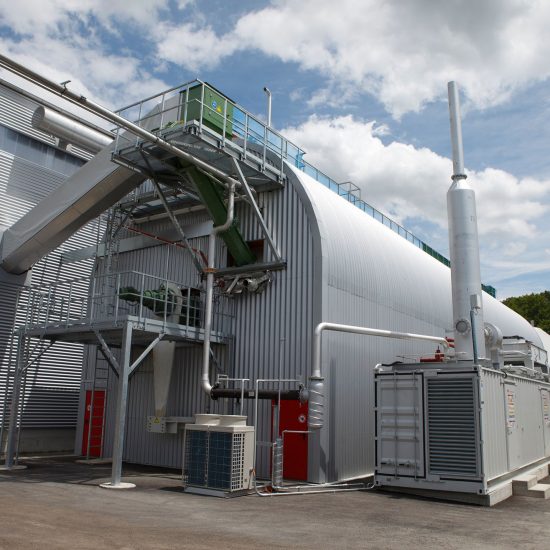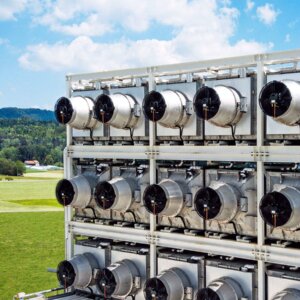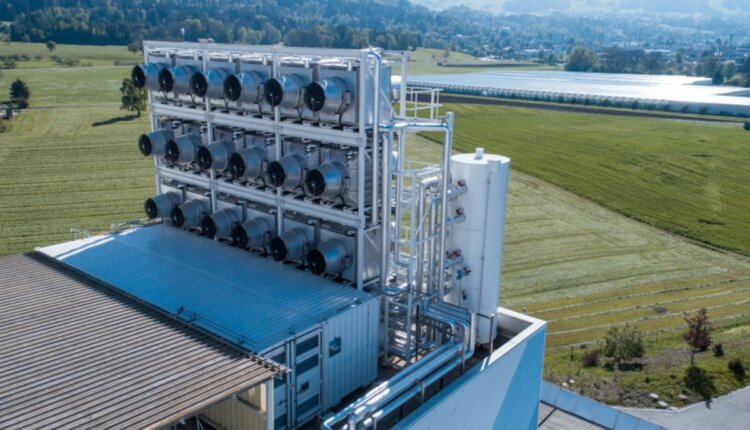Introduction to Direct Air Capture (DAC):
Direct Air Capture refers to a set of technologies designed to capture carbon dioxide (CO2) directly from the ambient air. Unlike traditional carbon capture methods that capture CO2 emissions from point sources like factories or power plants, DAC systems target CO2 from the atmosphere itself.
Working Principle:
DAC systems typically employ various chemical processes or sorbent materials to capture CO2 molecules from the air. These systems use large-scale fans or filters to draw in air, which then passes through chambers or materials that selectively absorb CO2 while allowing other gases to pass through.
The Direct Air Capture (DAC) process involves several steps to extract carbon dioxide (CO2) from the atmosphere :
- Air Intake:
- DAC facilities start by drawing in large volumes of ambient air. This air often passes through filters to remove particulates and impurities before entering the capture system.
- Adsorption or Absorption:
- Adsorption: In one method, DAC uses adsorbent materials like porous solids or specialized surfaces that have a high affinity for CO2 molecules. As the air flows through these materials, CO2 adheres to their surfaces, trapping the gas while allowing other components of the air to pass through.
- Chemical Absorption: Another approach involves exposing the air to a liquid solvent or chemical solution that selectively captures CO2. The solvent chemically reacts with CO2, effectively capturing it from the air.
- CO2 Separation:
- After adsorption or absorption, the captured CO2 needs to be separated from the adsorbent material or the solvent. This separation process varies based on the specific DAC technology used.
- CO2 Release and Collection:
- Once separated, the collected CO2 needs to be released from the adsorbent or solvent. This might involve changes in temperature or pressure to facilitate the release of CO2, leaving the adsorbent or solvent ready for reuse.
- Purified Air Release:
- After CO2 capture, the purified air, now depleted of CO2, is released back into the atmosphere. This step is crucial to ensure that the DAC process does not significantly alter the composition of atmospheric gases.
- CO2 Storage or Utilization:
- The captured CO2 can be stored underground through carbon capture and storage (CCS) methods or utilized for various purposes, such as in industrial processes, carbonation of beverages, or even in synthetic fuel production.

Direct Air Capture technologies encompass various methods and systems designed to capture carbon dioxide (CO2) directly from the atmosphere. Key DAC technologies:
- Adsorption-Based DAC:
- Porous Solids: Employing solid materials with high surface areas, such as zeolites, metal organic frameworks (MOFs), or activated carbon, to adsorb CO2 from the air.
- Chemisorbents: Utilizing specialized surfaces or materials that chemically react with CO2, trapping it as a chemical compound.
- Chemical Absorption DAC:
- Liquid Absorbents: Involves using liquid solvents that have a high affinity for CO2. The solvent absorbs CO2 from the air, forming a solution that is later processed to release and collect the captured CO2.
- Membrane Based DAC:
- Selective Membranes: Utilizing semi-permeable membranes that allow CO2 to pass through while blocking other gases. This separation process enables the extraction of CO2 from the air stream.
- Ionic Liquids and Sorbent Based DAC:
- Ionic Liquids: Using specialized ionic liquids that selectively absorb CO2 from the air and release it under specific conditions for storage or utilization.
- Sorbent Materials: Development of advanced sorbent materials with high selectivity for CO2 capture.
- Direct Ocean Capture:
- Exploration of technologies that involve exposing seawater or alkaline solutions to CO2, leading to chemical reactions that capture and remove CO2 from the atmosphere.
- Hybrid DAC Systems:
- Integration of multiple capture methods or technologies to improve efficiency and selectivity. For instance, combining adsorption with chemical absorption for enhanced CO2 capture.
- Innovative Process Optimization:
- Continuous research and development efforts focusing on optimizing processes, improving materials, and increasing efficiency to reduce the energy requirements and costs associated with DAC.

Each DAC technology has its unique mechanisms, advantages, and challenges. Research and development in this field aim to improve efficiency, reduce costs, and scale up these technologies for large-scale deployment to contribute significantly to global carbon reduction efforts.
Discuss each Direct Air Capture Technology need more topics but will include some points here:
1. Porous solids are materials that possess a network of pores or empty spaces within their structure. These voids or pores can vary in size, shape, and distribution, contributing to the material’s ability to adsorb gases, liquids, or other substances.
The porosity of these materials is a key characteristic that allows them to be used in various applications, including Direct Air Capture (DAC) technology for capturing carbon dioxide (CO2) from the atmosphere.
Some common types of porous solids used in DAC and other adsorption processes include:
- Zeolites: These are crystalline aluminosilicate minerals with a well-defined, porous structure. Zeolites have a high surface area and uniform pore sizes, making them effective adsorbents for gases and liquids.
- Metal-Organic Frameworks (MOFs): MOFs are a class of porous materials composed of metal ions or clusters connected by organic linkers. Their structures can be tailored to have specific pore sizes and shapes, allowing for selective adsorption of gases like CO2.
- Activated Carbon: Activated carbon is a highly porous form of carbon with a large surface area due to its extensive network of pores. It’s widely used in adsorption processes because of its ability to capture various gases and impurities.
- Silica Gel: Silica gel is a porous form of silica with high adsorption capacity, commonly used in desiccants and adsorbents for moisture and other substances.
2. Chemisorbents refer to materials or substances that undergo a chemical reaction when they come into contact with specific gases or compounds, leading to the adsorption or capture of those substances.
These materials are designed to chemically react with certain gases, rather than solely relying on physical adsorption, making them effective in capturing target molecules, such as carbon dioxide (CO2) in the context of Direct Air Capture (DAC) technology.
In the realm of DAC or carbon capture, chemisorbents play a crucial role in capturing CO2 directly from the air by reacting with and selectively binding CO2 molecules. This process involves the formation of chemical bonds between the CO2 and the surface of the chemisorbent material, resulting in the immobilization of CO2 molecules within the material’s structure.
Chemisorbents used in DAC technology often include specialized materials or surfaces that have a high affinity for CO2 and are engineered to react preferentially with CO2 over other gases present in the atmosphere. These materials can vary and may include amine-based compounds, metal oxides, or other functionalized surfaces that facilitate the chemical interaction and capture of CO2.
The captured CO2 can later be released from the chemisorbent material through various methods, allowing for the collection and potential storage or utilization of the captured CO2.
Chemisorbents are a significant area of research in DAC and carbon capture technologies, as they offer the potential for high selectivity, efficient capture, and subsequent release of CO2. Scientists and engineers continually explore and develop new chemisorbent materials with enhanced properties, such as improved selectivity, higher capacity, and better regeneration capabilities, aiming to improve the efficiency and feasibility of DAC processes.
Examples of chemisorbents used or studied for CO2 capture:
- Amine-Based Compounds:
- Amine-Functionalized Surfaces: Solid materials or surfaces functionalized with amine groups can chemically react with CO2, capturing it from the air. These materials might include modified polymers or solid surfaces with attached amine groups.
- Metal Oxides:
- Magnesium Oxide (MgO): MgO surfaces can react with CO2 to form stable carbonates, effectively capturing CO2 through chemical absorption.
- Calcium Oxide (CaO): Similar to MgO, CaO surfaces can chemically absorb CO2, forming calcium carbonate.
- Hydrotalcite-Like Compounds:
- Layered Double Hydroxides (LDHs): Certain LDHs can react with CO2, forming carbonate compounds. These materials have been studied for their potential in chemically absorbing CO2.
- Functionalized Polymers:
- Polymers with Specific Functional Groups: Some polymers or materials are designed with specific functional groups that have an affinity for CO2, allowing them to chemically react and capture CO2 molecules.
- Carbonic Anhydrase Enzymes:
- Biologically Derived Enzymes: Synthetic or biomimetic materials that mimic the action of carbonic anhydrase enzymes found in nature. These materials facilitate the conversion of CO2 to bicarbonate ions, effectively capturing CO2.
- Other Modified Surfaces or Materials:
- Researchers are exploring various modified surfaces, catalysts, and engineered materials with tailored properties to chemically capture CO2 from the air.

3. Chemical absorption Direct Air Capture (DAC) refers to a method of capturing carbon dioxide (CO2) from the atmosphere by using liquid solvents or chemical solutions that have a high affinity for CO2 molecules.
In Chemical Absorption DAC:
- Process:
- DAC systems employing chemical absorption pass the ambient air through a liquid solvent or solution that selectively reacts with CO2.
- The solvent chemically absorbs the CO2 molecules from the air, forming a solution containing dissolved CO2.
- Selective Interaction:
- The solvent used in this process is chosen for its ability to react with and absorb CO2 while allowing other gases, such as nitrogen and oxygen, to pass through without being absorbed.
- Capture Mechanism:
- The chemical absorption process involves the formation of chemical bonds or interactions between the CO2 molecules and the solvent molecules, effectively capturing the CO2.
- Separation and Collection:
- The solvent containing the dissolved CO2 is then processed further to separate and collect the captured CO2 from the solution. Techniques such as heating, changing pressure, or using specific catalysts may be employed to release the CO2 from the solvent.
- Regeneration of Solvent:
- After CO2 capture, the solvent is regenerated or treated to remove the captured CO2 and prepare it for reuse in the capture process.
- Storage or Utilization:
- The collected CO2 can be stored underground through carbon capture and storage (CCS) methods or utilized for various purposes, such as in industrial processes or for the production of synthetic fuels.
Chemical absorption DAC is one of the approaches used to capture CO2 from the atmosphere, alongside other methods like adsorption-based capture (using porous solids) or membrane-based systems. Each approach has its advantages and challenges in terms of efficiency, selectivity, energy requirements, and cost-effectiveness. Researchers continue to explore and improve chemical absorption methods and solvents to enhance the effectiveness and viability of DAC technologies for carbon capture and reduction efforts.
Examples of chemical absorption DAC methods:
- Amine-Based Solutions:
- Monoethanolamine (MEA): MEA is a commonly used solvent in carbon capture technologies. In DAC, it can be used to absorb CO2 from the air, forming a solution that contains dissolved CO2.
- Diethanolamine (DEA): Similar to MEA, DEA can react with and absorb CO2, making it a potential solvent for DAC applications.
- Potassium Carbonate Solutions:
- Solutions of potassium carbonate or other alkali metal carbonates have shown promise in capturing CO2 from the atmosphere. These solutions can chemically absorb CO2, forming carbonates.
- Aqueous Ammonia Solutions:
- Ammonia-based solutions have also been explored for DAC purposes. Aqueous ammonia can selectively capture CO2 when exposed to ambient air.
- Ionic Liquids:
- Some specialized ionic liquids have been investigated for their potential to chemically absorb CO2 from the atmosphere. These liquids have unique properties that make them suitable for capturing and storing CO2.
- Other Functionalized Solvents:
- Researchers are developing and testing various other solvents and functionalized liquids that have a high affinity for CO2 and can selectively absorb it from the air.
4. How Membrane Based DAC works ?

Membrane Technology:
Membranes used in DAC are engineered to have specific properties that enable the selective permeation of CO2. These membranes can be made from various materials, including polymers, ceramics, or hybrid materials.
Selective Permeability:
The membrane’s structure and composition are designed to allow CO2 molecules to pass through more readily compared to other gases such as nitrogen or oxygen. This selective permeability is based on differences in molecular size, solubility, or other characteristics.
Separation Process:
Ambient air containing CO2 is passed through the membrane. The membrane’s selective properties enable the preferential passage of CO2, allowing it to permeate through while other gases are largely retained on the feed side.
CO2 Collection:
On the other side of the membrane, a stream enriched with CO2 is collected. This collected stream contains a higher concentration of CO2 compared to the incoming ambient air.
Purification and Concentration:
The collected CO2 stream may undergo further purification steps to concentrate the captured CO2 and remove any residual gases before it can be stored or utilized.
Membrane-based DAC offers potential advantages such as lower energy consumption compared to some other DAC methods, as it relies on the selective permeation of gases through the membrane without the need for chemical reactions or large-scale equipment.
However, the effectiveness of membrane-based DAC depends on the membrane’s selectivity, permeability, durability, and scalability for large-scale CO2 capture.
5. Ionic liquids are a class of liquid salts composed entirely of ions, which are charged particles. Unlike common salts, which have high melting points and exist as solids at room temperature, ionic liquids are liquid at or near room temperature. They typically consist of large organic cations paired with various anions.
These liquids possess unique properties that make them distinct from traditional organic solvents or aqueous solutions:
- Low Volatility: Ionic liquids have low vapor pressures, meaning they evaporate much more slowly than conventional solvents. This property contributes to their stability and reduced environmental impact.
- High Thermal Stability: Many ionic liquids exhibit high thermal stability, allowing them to remain liquid over a wide temperature range, from below freezing to several hundred degrees Celsius.
- Tunable Properties: The chemical structure of ionic liquids can be modified by choosing different cations and anions, allowing for tailoring of their physical and chemical properties, such as viscosity, conductivity, and solubility.
- Good Solvents: Ionic liquids can dissolve a wide range of organic and inorganic compounds, making them versatile in various chemical processes and applications.
- Potential Green Solvents: Due to their low volatility, recyclability, and non-flammability, ionic liquids have gained attention as potential ‘green solvents’ in environmentally friendly processes.
In the context of carbon capture and utilization, some ionic liquids have been studied for their potential application in capturing carbon dioxide (CO2) emissions. Certain ionic liquids have shown the ability to selectively absorb CO2, making them of interest in processes like carbon capture from industrial emissions or in Direct Air Capture (DAC) technologies.
6. What is Direct Ocean Capture (DOC) ?

Direct Ocean Capture (DOC) refers to a concept that involves capturing carbon dioxide (CO2) directly from seawater. This approach aims to remove CO2 directly from the ocean, contributing to efforts to mitigate greenhouse gas emissions and reduce CO2 levels in the atmosphere.
The idea behind Direct Ocean Capture involves leveraging the natural processes of carbon uptake and storage that occur in the oceans. The oceans are vast reservoirs of carbon, and they naturally absorb CO2 from the atmosphere through physical and chemical processes.
Several proposed methods for Direct Ocean Capture include:
Alkalinity Enhancement:
Involves adding alkaline substances to seawater, such as calcium hydroxide or sodium hydroxide, which can react with dissolved CO2 to form bicarbonate ions. This increases the ocean’s alkalinity and enhances its capacity to store carbon.
Mineralization:
Utilizes natural or engineered processes to enhance the formation of carbonate minerals in the ocean. This involves accelerating the natural weathering of minerals like olivine or serpentine, which react with CO2 and water to form stable carbonates.
Direct CO2 Extraction from Seawater:
Involves using specialized equipment or materials to extract dissolved CO2 directly from seawater. This process often utilizes sorbents or membranes that selectively capture CO2 from the water.
Direct Ocean Capture is an area of ongoing research and development. While it holds promise as a potential method for carbon removal and storage, it faces various technical, environmental, and logistical challenges:
Scale and Impact: The vast scale of the oceans makes the effective capture and sequestration of CO2 challenging, and the potential impact on marine ecosystems requires careful consideration.
Cost and Energy Intensity: The energy requirements and costs associated with large-scale DOC operations could be substantial, affecting the economic viability of this approach.
Environmental Impacts: Altering the chemistry or alkalinity of seawater could have unintended consequences on marine life and ecosystems, necessitating thorough environmental impact assessments.

